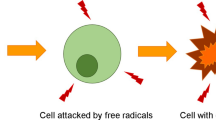Abstract
Generation of reactive oxygen species (ROS) is a normal process in the life of aerobic organisms. Under physiological conditions, these deleterious species are mostly removed by the cellular antioxidant systems, which include antioxidant vitamins, protein and non-protein thiols, and antioxidant enzymes. Since the antioxidant reserve capacity in most tissues is rather marginal, strenuous physical exercise characterized by a remarkable increase in oxygen consumption with concomitant production of ROS presents a challenge to the antioxidant systems.
An acute bout of exercise at sufficient intensity has been shown to stimulate activities of antioxidant enzymes. This could be considered as a defensive mechanism of the cell under oxidative stress. However, prolonged heavy exercise may cause a transient reduction of tissue vitamin E content and a change of glutathione redox status in various body tissues. Deficiency of antioxidant nutrients appears to hamper antioxidant systems and augment exercise-induced oxidative stress and tissue damage. Chronic exercise training seems to induce activities of antioxidant enzymes and perhaps stimulate GSH levels in body fluids. Recent research suggest that supplementation of certain antioxidant nutrients are necessary for physically active individuals.
Similar content being viewed by others
References
Chance B, Sies H, Boveris A: Hydroperoxide metabolism in mammalian organs. Physiol Rev 59: 527-605, 1979
Sen CK: Oxidants and antioxidants in exercise. J Appl Physiol 79: 675-686, 1995
Chakraborti T, Ghosh SK, Michael JR, Batabyal SK, Chakraborti S: Targets of oxidative stress in cardiovascular system. Mol Cell Biochem 187: 1-10, 1998
Jenkins RR: Free radical chemistry. Relationship to exercise. Sports Med: 5: 156-170, 1988
Jenkins RR: Exercise, oxidative stress, and antioxidants: A review. Int J Sport Nutr 3: 356-375, 1993
Chakraborti T, Das S, Mondal M, Roychoudhury S, Chakraborti S: Oxidant, mitochondria and calcium: An overview. Cell Signal 2: 77-85, 1999
Machlin LJ, Bendich A: Free radical tissue damage: protective role of antioxidant nutrients. FASEB J 1: 441-445, 1987
Davies KJ, Quintanilha AT, Brooks GA, Packer L: Free radicals and tissue damage produced by exercise. Biochem Biophys Res Commun 107: 1198-1205, 1982
Reid MB, Haack KE, Franchek KM, Valberg PA, Kobzik L, West MS: Reactive oxygen in skeletal muscle. I. Intracellular oxidant kinetics and fatigue in vitro. J Appl Physiol 73: 1797-1804, 1992
Meydani M, Evans WJ: In: B.P. Yu (eds), Free Radical and Ageing. CRC Press, Florida, 1993, pp 183-204
Gabriel H, Schwarz L, Steffens G, Kindermann W: Immunoregulatory hormones, circulating leucocyte and lymphocyte subpopulations before and after endurance exercise of different intensities. Int J Sports Med 13: 359-366, 1992
Ghosh SK, Chakraborti T, Banerjee AB, Roychoudhury S, Chakraborti S: Role of hydroxyl radical in superoxide induced microsomal lipid peroxidation: Protective effect of anion channel blocker. J Biosci 21: 35-43, 1996
Roychoudhury S, Ghosh SK, Chakraborti T, Chakraborti S: Role of hydroxyl radical in the oxidant H2O2-mediated Ca2+ release from pulmonary smooth muscle mitochondria. Mol Cell Biochem 159: 95-103, 1996
Dillard CJ, Litov RE, Savin WM, Dumelin EE, Tappel AL: Effects of exercise, vitamin E, and ozone on pulmonary function and lipid peroxidation. J Appl Physiol 45: 927-32, 1978
Kanter MM, Nolte LA, Holloszy JO: Effects of an antioxidant vitamin mixture on lipid peroxidation at rest and postexercise. J Appl Physiol 74: 965-969, 1993
Alessio HM: Exercise-induced oxidative stress. Med Sci Sports Exerc 25: 218-224, 1993
Stadtman ER: Metal ion-catalyzed oxidation of proteins: Biochemical mechanism and biological consequences. Free Rad Biol Med 9: 315-325, 1990
Salo DC, Donovan CM, Davies KJ: HSP70 and other possible heat shock or oxidative stress proteins are induced in skeletal muscle, heart, and liver during exercise. Free Radic Biol Med 11: 239-246, 1991
Ziegler DM: Role of reversible oxidation-reduction of enzyme thiols-disulfides in metabolic regulation. Annu Rev Biochem 54: 305-329, 1985
Ji LL, Stratman FW, Lardy HA: Enzymatic down regulation with exercise in rat skeletal muscle. Arch Biochem Biophys 263: 137-149, 1988
Meister A, Anderson ME: Glutathione. Annu Rev Biochem 52: 711-760, 1983
Hashimoto Y, Suzuki D, Hamada K, Okada H, Nagao N: Changes of expression of complement 3bi receptors on granulocytes after physical exercise in rats. J Sports Med Phys Fitness 36: 275-280, 1996
Suzuki K, Sato H, Kikuchi T, Abe T, Nakaji S, Sugawara K, Totsuka M, Sato K, Yamaya K: Capacity of circulating neutrophils to produce reactive oxygen species after exhaustive exercise. J Appl Physiol 81: 1213-1222, 1996
Packer L, Almada AL, Rothfuss LM, Wilson DS: Modulation of tissue vitamin E levels by physical exercise. Ann NY Acad Sci 570: 311-321, 1989
Kanter M: Free radicals, exercise and antioxidant supplementation. Proc Nutr Soc 57: 9-13, 1998
Ji LL: Oxidative stress during exercise: Implication of antioxidant nutrients. Free Radical Biol Med 18: 1079-1086, 1995
Niki E, Kawakami A, Saito M, Yamamoto Y, Tsuchiya J, Kamiya Y: Effect of phytyl side chain of vitamin E on its antioxidant activity. J Biol Chem 260: 2191-2196, 1985
Kuroda Y: Bio-antimutagenic activity of green tea catechins in cultured Chinese hamster V79 cells. Mutat Res 361: 179-186, 1996
Author information
Authors and Affiliations
Rights and permissions
About this article
Cite this article
Banerjee, A.K., Mandal, A., Chanda, D. et al. Oxidant, antioxidant and physical exercise. Mol Cell Biochem 253, 307–312 (2003). https://doi.org/10.1023/A:1026032404105
Issue Date:
DOI: https://doi.org/10.1023/A:1026032404105




